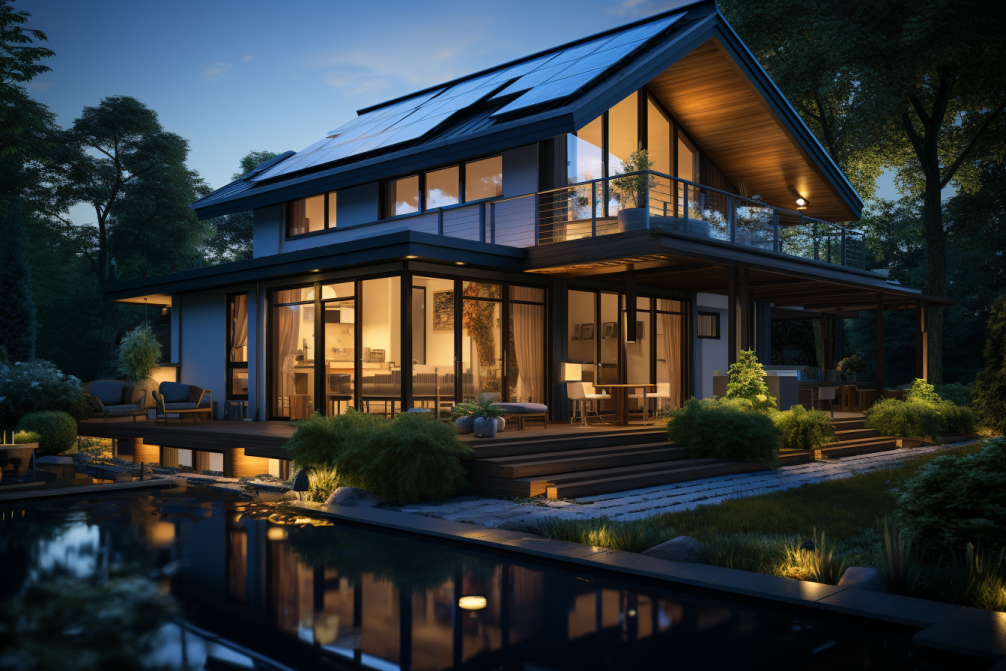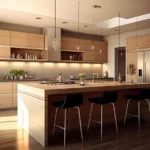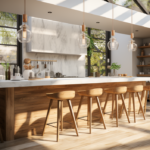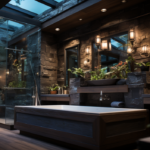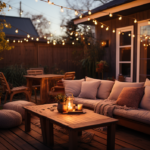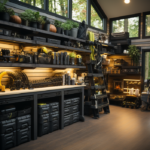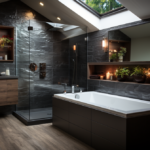Table of Contents
Making a Difference: Sustainable Home Improvements Worth Embracing
Hey there, eco-conscious homeowners! If you’re like me, you’re probably constantly on the lookout for ways to make your home more sustainable and environmentally friendly. Well, you’re in luck, because today I’m going to share with you some fantastic sustainable home improvements that deserve serious consideration.
In this day and age, living a more sustainable lifestyle is not only beneficial for the environment but also for our collective well-being. Making conscious choices when it comes to home improvements can have a significant impact on reducing our energy consumption, minimizing waste, and creating a healthier living environment for ourselves and future generations.
From energy-saving upgrades to innovative eco-friendly technologies, there are plenty of options available for every budget and every level of commitment. Whether you’re a complete newbie in the world of sustainability or an experienced green warrior, there’s something here for everyone.
In the upcoming articles, we’ll explore a range of sustainable home improvements that go beyond just installing energy-efficient light bulbs and recycling. We’ll delve into topics like solar power, rainwater harvesting, eco-friendly insulation, green building materials, and much more.
So, if you’re ready to join the movement towards a greener, more sustainable future, stay tuned and get inspired. Let’s transform our homes into eco-friendly havens that make a positive impact on the planet while still being stylish and comfortable. It’s time to make a difference, one sustainable improvement at a time!
Embrace Solar Power: Upgrade to Solar Panels for an Energy-Efficient Home
Are you tired of paying hefty electricity bills and want to reduce your carbon footprint? Look no further than harnessing the power of the sun with solar panels. This sustainable home improvement not only helps you save money in the long run but also allows you to contribute to a cleaner environment.
Solar panels work by converting sunlight into electricity, making them a reliable and renewable energy source. By installing solar panels on your roof, you can generate your own electricity and reduce your reliance on traditional fossil fuel-based energy. Plus, any excess power you generate can be sold back to the grid, adding another layer of financial benefit to your investment.
But the benefits don’t stop there. Embracing solar power also means you’ll be reducing your carbon footprint. Traditional energy generation methods release harmful greenhouse gases into the atmosphere, contributing to climate change. By opting for solar panels, you are actively choosing a more sustainable and eco-friendly energy alternative.
Moreover, solar panels require minimal maintenance and have a lifespan of around 25 to 30 years, meaning you can enjoy the benefits for decades to come. As the technology continues to advance, solar panels are becoming more efficient and affordable, making them an increasingly attractive option.
Before you jump into installing solar panels, consider factors such as your home’s location, roof orientation, and shading. Seek advice from reputable solar companies who can guide you through the process and provide a tailored solution for your specific needs. It’s important to note that government incentives and tax credits are often available to assist with the initial installation costs.
By embracing solar power and upgrading to solar panels, you can significantly reduce your energy bills, lower your carbon footprint, and become part of the growing movement towards a sustainable future. So why not make the switch and let the sun power your home?
No products found.
Conserve Water: Install Rainwater Harvesting Systems for Sustainable Water Usage
Water is a precious resource, and with increasing concerns about water scarcity, it’s crucial that we find ways to conserve and efficiently use this valuable asset. One sustainable home improvement that allows you to do just that is installing a rainwater harvesting system.
By collecting rainwater, you can reduce your reliance on municipal water supplies for various household purposes, such as watering your garden, cleaning outdoor spaces, and even flushing toilets. It’s a simple yet effective way to contribute to water conservation efforts while reducing your water bills.
How does it work?
Rainwater harvesting systems typically involve the collection of rainwater from your roof and storing it in tanks or underground cisterns. The water is then filtered and can be used throughout your home for non-potable water needs.
Benefits of rainwater harvesting
- Sustainable water usage – By utilizing rainwater, you reduce your demand for freshwater resources, helping to preserve this precious natural resource.
- Cost savings – Once you’ve installed a rainwater harvesting system, your water bills are likely to decrease, especially during the dry seasons.
- Flourishing plants – Rainwater is natural and free from the added chemicals found in tap water. Gardens and plants tend to thrive when nourished with rainwater.
- Resiliency – During water shortages or restrictions, having a rainwater harvesting system ensures that you have a reserve of water available.
Considerations when installing a system
Before installing a rainwater harvesting system, consider the following factors:
- Roof type and size – The area and material of your roof play a role in determining the amount of rainwater you can collect.
- Local regulations – Check with your local authorities to understand any regulations or permits required for rainwater harvesting systems.
- Maintenance – Regular maintenance, such as cleaning gutters and filters, is essential to ensure proper functioning of the system and to avoid contamination.
So, if you’re looking for a sustainable home improvement that conserves water, reduces your water bills, and promotes environmental responsibility, installing a rainwater harvesting system is a fantastic option. Start embracing water sustainability and make a positive impact on our planet’s water resources.
No products found.
Go Green with Insulation: Opt for Eco-Friendly Insulation Materials
When it comes to keeping our homes comfortable, insulation plays a crucial role. But did you know that you can make your insulation choices more sustainable by opting for eco-friendly materials? Here’s why you should consider going green with insulation:
Benefits of eco-friendly insulation
- Energy efficiency – Choosing eco-friendly insulation materials can significantly improve the energy efficiency of your home. These materials have excellent thermal properties, which means they can help keep your home cooler in the summer and warmer in the winter, reducing your reliance on energy-consuming heating and cooling systems.
- Reduced environmental impact – Traditional insulation materials, such as fiberglass and foam, can have adverse effects on the environment during production and disposal. Eco-friendly insulation, on the other hand, is made from renewable or recycled materials, reducing the demand for new resources and minimizing waste.
- Improved indoor air quality – Many conventional insulation materials release harmful chemicals and volatile organic compounds (VOCs) into the air, negatively impacting indoor air quality. Eco-friendly options are free from these harmful substances, creating a healthier living environment for you and your family.
Types of eco-friendly insulation
- Cellulose insulation – Made from recycled paper and treated with non-toxic chemicals to resist fire and pests, cellulose insulation is a popular eco-friendly choice.
- Wool insulation – Wool is a renewable and biodegradable material that provides excellent insulation properties. It is also naturally resistant to fire, pests, and mold.
- Cotton insulation – Made from recycled cotton fibers, this insulation material is free from chemicals and is an excellent option for those with chemical sensitivities.
- Recycled denim insulation – Utilizing recycled blue jeans, this insulation provides effective thermal insulation while helping to reduce textile waste.
Considerations when choosing eco-friendly insulation
When selecting eco-friendly insulation materials, it’s essential to consider factors such as insulation R-value, installation requirements, and compatibility with your existing home structure. Consulting with insulation professionals can help you make the right choice based on your specific needs and budget.
By opting for eco-friendly insulation materials, you not only create a more energy-efficient and comfortable home but also reduce your carbon footprint and contribute to a greener future. So, why not go green with insulation and make a positive impact on both your home and the environment?
No products found.
Light the Way: Illuminate Your Home with Energy-Efficient LED Lighting
When it comes to sustainable home improvements, don’t overlook the importance of lighting. By switching to energy-efficient LED lighting, you can reduce your energy consumption, lower your electricity bills, and contribute to a greener planet. Here’s why you should consider illuminating your home with LED lighting:
Benefits of LED lighting
- Energy efficiency – Compared to traditional incandescent bulbs, LEDs are incredibly energy-efficient, using up to 80% less energy to produce the same amount of light. This means significant savings on your energy bills while reducing your environmental impact.
- Long-lasting – LED bulbs have an incredibly long lifespan, lasting up to 25 times longer than traditional bulbs. This means fewer replacements and less waste generated.
- Durability – LED bulbs are more durable and resistant to shocks, vibrations, and extreme temperatures, making them ideal for both indoor and outdoor use.
- Instant illumination – Unlike fluorescent or compact fluorescent lamps (CFLs), LED bulbs provide instant brightness without any flickering or warm-up time.
Creating the perfect LED lighting scheme
- Choose the right color temperature – LED bulbs come in various color temperatures, ranging from warm to cool. Consider the mood and functionality of each room when selecting the appropriate color temperature.
- Combine task and ambient lighting – Optimize energy usage by incorporating task lighting for specific activities while combining it with ambient lighting to create a cozy and inviting atmosphere.
- Utilize dimmers and smart lighting – Dimmers not only allow you to adjust the lighting levels but also extend the lifespan of LED bulbs. Additionally, smart lighting systems offer the flexibility to control and automate your lighting, further increasing energy efficiency.
- Make use of natural light – Maximize the use of natural light during the day by opening curtains or blinds and strategically placing mirrors to reflect and distribute natural light throughout your space.
By embracing LED lighting, you not only reduce your energy consumption and save money but also contribute to a more sustainable future. So, why wait? Make the switch and illuminate your home the energy-efficient way with LED lighting.
No products found.
Say Goodbye to Plastic: Switch to Sustainable and Recyclable Building Materials
In our efforts to create more sustainable homes, it’s crucial to consider the materials we use in our construction and renovation projects. One significant step towards sustainability is saying goodbye to plastic and embracing sustainable and recyclable building materials. Here’s why you should make the switch:
Benefits of sustainable and recyclable building materials
- Reduced environmental impact – Unlike plastic, sustainable materials are often made from renewable resources or recycled materials, significantly reducing the carbon footprint associated with their production.
- Longevity – Sustainable materials are designed to be durable and long-lasting, ensuring that your home remains structurally sound for years to come. This reduces the need for frequent replacements and contributes to waste reduction.
- Improved indoor air quality – Many traditional building materials contain harmful chemicals that can off-gas and negatively affect indoor air quality. Sustainable materials, on the other hand, are often free from these toxins, promoting a healthier living environment.
- Enhanced aesthetics – Sustainable materials offer a wide range of options that can add a unique and aesthetically pleasing touch to your home. Whether it’s bamboo flooring, reclaimed wood accents, or recycled glass countertops, you can create a stylish and eco-friendly space.
Examples of sustainable and recyclable building materials
- Bamboo – Bamboo is a fast-growing, renewable resource that can be used for flooring, furniture, and even structural elements. It’s incredibly durable and offers a beautiful natural aesthetic.
- Reclaimed wood – Salvaged from old buildings or repurposed from other sources, reclaimed wood adds character and warmth to your home while reducing the demand for newly harvested timber.
- Recycled glass – Used glass can be transformed into stunning countertops, tiles, or decorative accents. It’s an excellent way to divert waste from landfills and create a unique, eco-friendly design element.
- Natural insulation – Materials like sheep’s wool, cotton, and cellulose can be used as insulation alternatives to traditional fiberglass, providing effective thermal insulation while minimizing environmental impact.
Considerations when using sustainable materials
Before incorporating sustainable materials into your home, ensure they meet your specific needs in terms of durability, cost, and maintenance. Additionally, look for certifications such as Forest Stewardship Council (FSC) for wood products or ENERGY STAR ratings for energy-efficient materials.
By eliminating plastic and embracing sustainable and recyclable building materials, you not only reduce your impact on the environment but also create a healthier and more aesthetically appealing home. Embrace the transition towards a more sustainable future and make your building materials choices count!
Harness Geothermal Energy: Consider Geothermal Heating and Cooling Systems
Looking for a sustainable way to heat and cool your home? Consider harnessing the power of geothermal energy. Geothermal heating and cooling systems provide a renewable, energy-efficient, and eco-friendly solution for keeping your home comfortable. Here’s why you should consider this sustainable home improvement:
Benefits of geothermal heating and cooling systems
- Renewable energy source – Geothermal systems utilize the thermal energy stored beneath the Earth’s surface, making it a renewable and sustainable energy source. By tapping into this natural heat, you reduce your reliance on traditional fossil fuel-based heating and cooling methods.
- Energy efficiency – Geothermal systems are incredibly energy-efficient, typically providing 3-4 units of energy for every unit of electricity consumed. This high efficiency translates into significant energy savings and lower utility bills.
- Long-term cost savings – While the initial installation cost may be higher, the long-term savings from reduced energy consumption can outweigh the upfront investment. Additionally, geothermal systems have minimal maintenance requirements, resulting in lower maintenance costs over time.
- Environmental friendliness – Geothermal systems produce no direct emissions and have a minimal carbon footprint. By opting for geothermal heating and cooling, you actively contribute to reducing greenhouse gas emissions and fighting climate change.
How geothermal systems work
Geothermal systems operate by utilizing the stable temperature of the Earth to regulate the temperature in your home. During winter, the system extracts heat from the ground and transfers it indoors to warm your home. In the summer, the process is reversed, with heat from your home being absorbed by the system and released into the cooler ground.
The main components of a geothermal system include a ground loop system buried beneath the surface, a heat pump, and a distribution system that controls the heating and cooling of your home.
Considerations when installing a geothermal system
Before installing a geothermal system, several factors should be considered, including your property’s suitability for a ground loop system, the size of your heating and cooling loads, and the availability of qualified professionals in your area.
By harnessing geothermal energy for heating and cooling your home, you not only enjoy year-round comfort but also contribute to a more sustainable future. Harness the Earth’s natural heat and make a positive impact on your energy consumption and the environment with geothermal systems.
Improve Indoor Air Quality: Invest in Natural Ventilation and Air Purification Systems
When it comes to creating a healthy and sustainable home, improving indoor air quality is crucial. Poor air quality can lead to a range of health issues and discomfort. To promote a fresh and breathable environment, consider investing in natural ventilation and air purification systems. Here’s why it’s an essential sustainable home improvement:
Benefits of improving indoor air quality
- Health and well-being – Clean air is essential for our health. By improving indoor air quality, you reduce the risk of respiratory problems, allergies, and other health issues associated with pollutants, allergens, and volatile organic compounds (VOCs).
- Energy efficiency – Natural ventilation systems use natural air movement and can help reduce your reliance on energy-consuming mechanical ventilation systems. This translates into energy savings and a reduced carbon footprint.
- Comfort and productivity – Good air quality improves comfort levels, allowing you to relax and focus better. It can enhance your overall well-being, making you more productive in your home environment.
Natural ventilation systems
- Windows and doors – Open windows and doors allow fresh air to circulate and provide natural ventilation. Consider cross-ventilation by strategically placing windows to maximize air flow.
- Skylights and roof vents – Installing skylights or roof vents can help draw out hot air and improve air circulation in your home.
Air purification systems
- HEPA filters – High-Efficiency Particulate Air (HEPA) filters are effective in capturing microscopic pollutants like dust, pollen, pet dander, and mold spores. Look for HEPA filters in air purifiers or HVAC systems.
- Activated carbon filters – These filters are excellent for removing odors, tobacco smoke, and certain chemicals from the air. They work by adsorbing and neutralizing these pollutants.
- Plants – Indoor plants can naturally purify the air by absorbing harmful chemicals and releasing oxygen. Some popular air-purifying plants include spider plants, peace lilies, and snake plants.
Considerations when improving indoor air quality
When investing in natural ventilation or air purification systems, consider factors such as your home’s layout and size, the level of outdoor air pollution, and the specific needs of your household members, especially those with allergies or respiratory sensitivities.
By improving indoor air quality, you create a healthier and more comfortable living space for you and your loved ones. It’s a sustainable home improvement that enhances well-being while reducing energy consumption. Breathe in fresh, clean air and make your home a haven of purity and tranquility.
Embrace Sustainable Landscaping: Create an Eco-Friendly Garden with Native Plants
When it comes to sustainable home improvements, don’t forget about your outdoor space. Embracing sustainable landscaping practices and incorporating native plants into your garden can have a positive impact on the environment while creating a beautiful and low-maintenance outdoor oasis. Here’s why you should consider this eco-friendly approach:
Benefits of sustainable landscaping with native plants
- Water conservation – Native plants are adapted to the local climate, requiring less water to thrive once established. By choosing plants that are naturally suited to your region, you can reduce your outdoor water usage and conserve this precious resource.
- Biodiversity – Native plants attract local wildlife such as bees, butterflies, and birds. They provide food and habitat for these beneficial creatures, contributing to the biodiversity and ecological balance of your garden.
- Reduced chemical use – Native plants are naturally resistant to pests, diseases, and harsh weather conditions, reducing the need for chemical pesticides and fertilizers. This promotes a healthier ecosystem and reduces chemical runoff into waterways.
- Low-maintenance – Once established, native plants generally require less maintenance, as they have already adapted to the local soil and climate conditions. This means less time spent on watering, pruning, and other garden chores.
Choosing and incorporating native plants
- Research native species – Take the time to research native plant species that are suitable for your specific region, considering factors such as soil type, sunlight exposure, and moisture levels.
- Consider the ecosystem – Select a diverse range of plants that provide food and shelter for wildlife throughout the year. Aim for a mix of trees, shrubs, grasses, and flowering plants to create a balanced ecosystem.
- Mulching and composting – Use organic mulch and compost to nourish your garden naturally, retaining moisture, preventing weed growth, and enriching the soil.
- Rain gardens and natural drainage – Incorporate rain gardens or natural drainage solutions to capture and utilize rainwater, reducing water runoff and promoting healthy plant growth.
By embracing sustainable landscaping practices and choosing native plants, you contribute to environmental conservation, support regional ecosystems, and create a stunning, low-maintenance garden. Enjoy the beauty of nature right in your backyard while making a positive impact on the planet. Let your garden become a haven for both you and the local flora and fauna!
Upgrade Your Windows: Install Energy-Efficient Windows for Enhanced Insulation
If you’re looking to make your home more energy-efficient and comfortable, upgrading your windows is a fantastic sustainable home improvement to consider. Energy-efficient windows not only help to insulate your home but also contribute to cost savings and reduced environmental impact. Here’s why you should upgrade your windows:
Benefits of energy-efficient windows
- Improved insulation – Energy-efficient windows are designed to minimize heat transfer, keeping the outside elements at bay and maintaining a comfortable indoor temperature year-round. They help to prevent drafts, reduce energy loss, and lessen the workload on your heating and cooling systems.
- Financial savings – By upgrading to energy-efficient windows, you can save on your energy bills. The improved insulation properties of these windows allow you to rely less on artificial heating and cooling, resulting in significant cost savings in the long run.
- Reduced carbon footprint – Decreased energy consumption means a reduced carbon footprint. By upgrading to energy-efficient windows, you actively contribute to environmental conservation by decreasing greenhouse gas emissions associated with heating and cooling.
- Noise reduction – Energy-efficient windows often feature multiple panes of glass and special coatings that help to reduce noise transmission. This can be especially beneficial if you live in a noisy neighborhood or near busy streets.
Options for energy-efficient windows
- Double-pane or triple-pane windows – These windows have two or three layers of glass with an insulating gas fill in between. They provide better insulation than single-pane windows and improve energy efficiency.
- Low-emissivity (Low-E) coatings – Low-E coatings on windows help to reflect heat and harmful UV rays while allowing natural light to enter your home. They help to keep your home cooler in the summer and warmer in the winter.
- Frame materials – Window frames made from materials such as vinyl, fiberglass, or wood with proper insulation can contribute to energy efficiency. Each material has its own advantages, so consider factors like durability, maintenance requirements, and aesthetic appeal before making a choice.
Considerations when upgrading windows
When upgrading your windows, consider factors like your climate, local building codes, and budget. Consult with window professionals who can guide you in choosing the right windows for your specific needs and provide expert installation services.
By upgrading to energy-efficient windows, you create a more comfortable living space, reduce your energy consumption, and contribute to a greener future. So, why wait? Let more natural light in, keep the elements out, and give your home a sustainable makeover with energy-efficient windows.
Sustainable Flooring Options: Explore Eco-Friendly Materials for a Stylish and Green Home
When it comes to sustainable home improvements, don’t forget about your flooring. Opting for eco-friendly materials not only adds style to your home but also helps to reduce your carbon footprint. It’s time to explore sustainable flooring options that are not only environmentally conscious but also aesthetically pleasing:
Benefits of sustainable flooring
- Reduced environmental impact – Choosing sustainable flooring materials means opting for renewable resources or recycled materials. This reduces the demand for new resources and minimizes waste and environmental degradation.
- Improved indoor air quality – Many conventional flooring materials contain harmful chemicals that can off-gas and impact air quality. Sustainable options are often free from toxic compounds, ensuring a healthier living environment.
- Durability – Sustainable flooring materials are designed to be long-lasting and resilient. They can withstand heavy foot traffic, reducing the need for frequent replacements and extending the lifespan of your flooring.
Eco-friendly flooring options
- Bamboo – Bamboo is a fast-growing grass that is harvested sustainably and can be used as an alternative to hardwood flooring. With its durability and unique grain patterns, bamboo adds a touch of elegance to any space.
- Cork – Made from the bark of cork oak trees, cork flooring is a renewable and biodegradable option. It is comfortable to walk on, provides natural insulation, and has excellent acoustic properties.
- Reclaimed wood – Salvaged from old buildings, barns, or other sources, reclaimed wood offers a rustic and character-filled flooring option. It adds warmth and history to your home while reducing the demand for new timber.
- Linoleum – Made from natural materials such as linseed oil, wood flour, and jute, linoleum is a durable and versatile choice. It’s available in a wide range of colors and patterns, giving you plenty of design options.
Considerations when choosing sustainable flooring
When selecting sustainable flooring options, consider factors such as the material’s durability, maintenance requirements, and compatibility with your lifestyle and design preferences. Additionally, seek out certifications like Forest Stewardship Council (FSC) or FloorScore to ensure the eco-friendliness of the product.
By exploring sustainable flooring options, you can create a stylish and green home that aligns with your environmental values. Enhance the beauty of your space while minimizing your impact on the planet. Choose sustainable flooring and step towards a more sustainable future, one stylish and eco-friendly floor at a time.
Conclusion
In conclusion, incorporating sustainable home improvements is not only beneficial for the environment but also for your overall well-being. By making conscious choices and embracing eco-friendly options, you can create a home that is both stylish and environmentally responsible.
From upgrading to solar panels and investing in energy-efficient windows to embracing natural ventilation, every sustainable choice you make contributes to reducing your carbon footprint and conserving valuable resources. Not only do these improvements save you money in the long run, but they also create a healthier and more comfortable living environment for you and your family.
Sustainable home improvements go beyond just reducing energy consumption; they encompass every aspect of your home, from flooring choices to landscaping and beyond. By choosing materials that are renewable, recyclable, and non-toxic, you can contribute to a greener future while enjoying a beautiful and sustainable home.
So, whether you’re starting small with LED lighting and energy-efficient appliances or taking on bigger projects like installing solar panels or switching to sustainable flooring, every effort counts. By joining the sustainable living movement, you become an agent of positive change, creating a better world for ourselves and future generations.
So, let’s take the leap together and embark on this journey towards a more sustainable and environmentally friendly home. The power is in our hands to make a difference, one sustainable improvement at a time.

